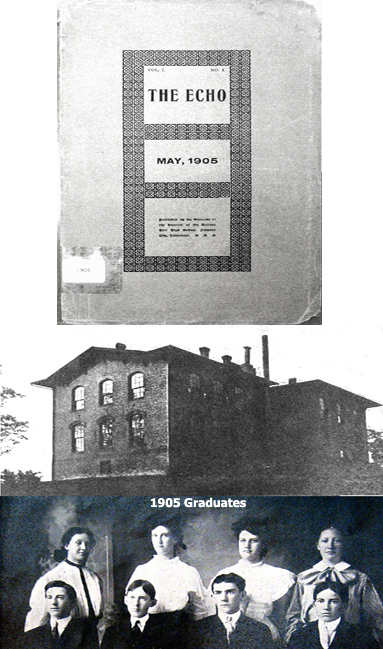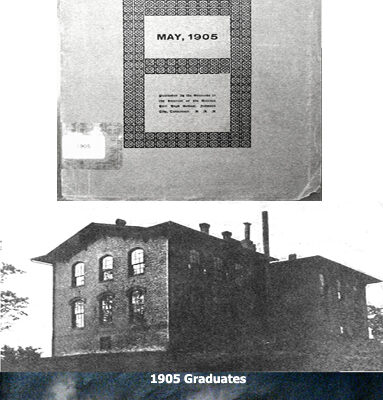Kathleen Hall, librarian at Science Hill High School, shared with me a copy of the school’s first annual, a May 1905 publication known as The Echo (Vol. 1, No. 1).
The Editor-in-Chief was Fred King. Assistant Editors were Emma Hatcher, Fra Matson, Lucy Sitton, Arthur Weaver and Ralph Preas. The Committee on Advertisements included Swannie Robinson and Roma Eiseman.
The smallish 58-page softbound slick paper publication was quite different from annuals today with more of an academic emphasis on a variety of subjects as opposed to a social focus on student activities, news, clubs and sports.

Several editorial comments were featured. “There is no reason why (the school) should be in the rear,” said one. “Other schools publish a paper of some kind and we are determined not to be outdone, hence this effort.” … “In January, the building was slightly damaged by fire. Since then, a fire escape has been added. This will prove indispensable in case of fire if we may judge by the excitement prevalent at the last alarm.” … “This issue of the Echo has been very much delayed on account of the recent fire destroying all our photographs. Next year we promise to have it out on time if not burnt out again.”
One student, Cecil B. Donnelly, offered a brief history of the class of 1905, noting that it was comprised of eight students: Leonidas W. McCown (president), Fred King (vice-president), Maude Beasley (secretary-treasurer), Claire Fulton, Walter Faw Broyles, Ella Russell, Una V. Templin and himself.
Most of the class members were products of Johnson City schools through the tenth grade. The teachers mentioned were Rhoda Campbell, Clara Cloyd, Sue Wood, Laura King, Mattie Bullock, Mary Brown, Ina Yoakley, Willie Reeves and Kate Simpson, W.P. Crouch and John H. Pence.
The school colors were olive and white. The class pin was a wreath surrounding a scroll upon which were carved the letters, “J.C.H.S.” “Non Summas, sed Adscendens” was the motto chosen by those in harmony with the ambition and lofty ideals of the members of the class who were about to embark upon the “storm-tossed sea of life.”
Under a section titled, “Class Prophecy,” Maude Leo Beasley came into possession of a device known as a Mysterioscope that recorded with unerring accuracy the things of the future. Pressing the Telegnostikon key on the instrument revealed what the future held for her classmates. She commented on a few of them.
E.C. Reeves wrote a short essay giving the school’s history, which he stated opened its doors about 45-years ago (1869). The school first organized at Oak Grove as a debating society, located “about two and one-half miles from Johnson City.” Membership included J.M. Carr, H.H. Carr, William Taylor, I.E. Reeves, J.D. Reeves, R.H. Reeves and E.C. Reeves. One year later, the group transferred to Brush Creek Campground, “near where now stands the brick tobacco warehouse west of the city.”
Later, Tipton Jobe donated land for a new school on a downtown hill that was referred to as Science Hill. The new facility was appropriately tagged Science Hill Male and Female Institute. For a time, it served the dual role of school and place of worship for area churches. Eventually, the congregations built their own sanctuaries, leaving the brick structure on the hill solely for education. “The work of the small debating society,” said Reeves, “now almost forgotten, had been as bread cast upon the waters.”
J.E. Brading penned a section that lobbied for a new high school to abate over-crowding and allow a more favorable 30 students per teacher ratio. The Board of Education asked the City Council to erect a new high school.
Next, J.F. Templin provided a short history of two area grammar schools, Columbus Powell and Martha Wilder.
A clever five-verse anonymous poem titled, “His Compensation,” dealt with a student being “kep’ in” after school for detention hall for a variety of school infractions. The last two stanzas humorously read, “I’m kep’ in ef I whisper, An’ I’m kep’ in ef I chaw, The piece of gum I’ve borried, An’ am warmin’ my jaw. The truth is ‘at I’m kep’ in, Most everything I do, But one jolly thing about it, Is the teacher’s kep’ in too.”
Swannie Robinson composed a treatise that dealt with her climbing a hill and noting how the sky dramatically changed as she ascended from “sky blue” to yellow, orange and red as if the very heavens themselves were on fire. Other brief essays were “Mildred’s Heroism, (person not identified)” “How Jim Fooled the Boys” (Arthur Weaver) and “A Mountain Trip” (Oran Ward).
The annual contained a sketch of the Tennessee state flag that on April 17, 1905 was adopted as the official state flag. LeRoy Reeves, an 1894 alumnus of Johnson City High School, who at the time was a lawyer and captain of Johnson City’s National Guard, designed it. The significance of the stars, circle and colors was explained.
Included in The Echo was a list of graduates from 1894 to 1904, including an update of their whereabouts and careers in 1905. One name listed was Regina Eiseman who was educated at Virginia Institute and later became principal of Junior High School.
Another entry was a facsimile program for the “Seventh Anniversary; Science Hill Literary Society; Johnson City, Tennessee; Saturday Night; September 21, 1872; 7 O’clock, P.M.” A printed agenda was distributed to attendees: Prayer, Song by the Choir, Address by the President (H.H. Carr), Oration: Eulogy on Columbus (W.M. Boring), Declamation: The Women of the South (F.H. Berry), Debate: Should Capital Punishment be Abolished? (W.P. Rankin, J.C. King, A.B. Bowman and E.F. Akard), Song, Annual Address (J.M. Johnson) and Benediction.
The annual concluded with 21 business ads: I.M. Beckner; Kirkpatrick, Williams & Bowman; H.W. Pardue; Johnson City Traction Co.; Watauga Electric Company; J.M. Buck Lumber Co.; Frank Taylor; City Drug Co.; The Bee Hive; G.H. Shoun & Co.; Summers-Parrott Hardware Co.; Johnson City Bottling Works; Dulaney-Bailey Co.; Hart and Houston Store; Gump Brothers; Brading & Marshall; J.W. Cass; Wofford Brothers Insurance; D.A. Vines; Unaka National Bank; and Biddle and Ellsworth.

Comments are closed.